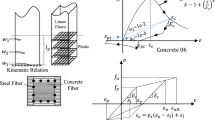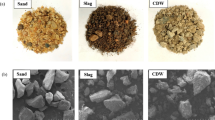Abstract
The Rankine earth pressure theory is extended herein to an inclined c–ϕ backfill. An analytical approach is then proposed to compute the static passive and active lateral earth pressures for a sloping cohesive backfill retained by a vertical wall, with the presence of wall–soil interface adhesion. The proposed method is based on a limit equilibrium analysis coupled with the method of slices wherein the assumed profile of the backfill failure surface is a composite of log-spiral and linear segments. The geometry of the failure surface is determined using the stress states of the soil at the two boundaries of the mobilized soil mass. The resultant lateral earth thrust, the point of application, and the induced moment on the wall are computed considering global and local equilibrium of forces and moments. Results of the proposed approach are compared with those predicted by a number of analytical models currently adopted in the design practice for various combinations of soil’s frictional angles, wall–soil interface frictional angles, inclined angles of backfill and soil cohesions. The predicted results are also verified against those obtained from finite element analyses for several scenarios under the passive condition. It is found that the magnitude of earth thrust increases with the backfill inclination angle under both the passive and active conditions.

















Similar content being viewed by others
Notes
† In design practice, it is conventional to assume a constant value of δw, even though the wall friction is generally not mobilized uniformly along the height of a retaining wall [19, 24]. Different values of δw are required in the calculation of active and passive earth pressures. The selection of suitable value of δw depends on the type of backfill and wall materials [16].
References
AASHTO (2012) AASHTO LRFD bridge design specifications, 6th edn. American Association of State Highway and Transportation Officials, Washington
ABAQUS (2007) ABAQUS documentation, version 6.7
Alejano LR, Antonio B (2012) Drucker–Prager criterion. Rock Mech Rock Eng 45(6):995–999
Atkinson JH (1981) Foundations and slopes: an introduction to applications of critical state soil mechanics. McGraw-Hill, London
Caltrans (2012) Caltrans reference manual for the design of earth retaining structures. California Department of Transportation, Sacramento
Caquot A, Kerisel J (1948) Tables for the calculation of passive pressure, active pressure and bearing capacity of foundations. Gauthier-Villars, Paris
Chen WF, Liu XL (1990) Limit analysis in soil mechanics. Elsevier, Amsterdam, pp 1–477
Chen WF, Rosenfarb JL (1973) Limit analysis solutions of earth pressure problems. Soils Found 13(4):45–60
Cheng YM (2016) Rankines earth pressure coefficients for inclined ground reconsidered by slip lime method. MOJ Civil Eng 1(1):1–7
Colmenares L, Zoback M (2002) A statistical evaluation of intact rock failure criteria constrained by polyaxial test data for five different rocks. Int J Rock Mech Min Sci 39(6):695–729
Coulomb C (1776) Essai sur une application de maximis et minimis à quelques problèmes de statique, relatifs à l’Architecture, pubblicato tra i “.Mèmoires de Mathématique et de Physique présentés à l’Académie Royale des Sciences, par divers Savans, et lûs dans les Assemblées, 7, Paris, pp 143–167
Davis RO, Selvadurai APS (2002) Plasticity and geomechanics. Cambridge University Press, Cambridge
Drucker DC, Prager W (1952) Soil mechanics and plastic analysis for limit design. Q Appl Math 10(2):157–165
Fang Y, Ho Y, Chen T (2002) Passive earth pressure with critical state concept. J Geotech Geoenviron Eng 128(8):651–659
Fang Y, Chen J, Chen C (1997) Earth pressures with sloping backfill. J Geotech Geoenviron Eng 123(3):250–259
GEOGUIDE (2000) Guide to retaining wall design. Geotechnical Engineering Office, Hong Kong, pp 1–259
Helwany S (2007) Applied soil mechanics with Abaqus applications. Wiley, New York, p 265
Iskander M, Omidvar M, Elsherif O (2013) Conjugate stress approach for Rankine seismic active earth pressure in cohesionless soils. J Geotech Geoenviron Eng 139(7):1205–1210
James RG, Bransby PL (1970) Experimental and theoretical investigations of a passive earth pressure problem. Geotechnique 20:17–37
Kumar J, Subba Rao KS (1997) Passive pressure coefficients, critical failure surface and its kinematic admissibility. Géotechnique 47(1):185–192
Kumar J, Chitikela S (2002) Seismic passive earth pressure coefficients using the method of characteristics. Can Geotech J 39(2):463–471. https://doi.org/10.1139/t01-103
Lin YL, Yang X, Yang GL, Li Y, Zhao LH (2017) A closed-form solution for seismic passive earth pressure behind a retaining wall supporting cohesive–frictional backfill. Acta Geotech 12(2):453–461
Mazindrani ZH, Ganjali MH (1997) Lateral earth pressure problem of cohesive backfill with inclined surface. J Geotech Geoenviron Eng 123(2):110–112
Milligan GWE, Bransby PL (1976) Combined active and passive rotational failure of a retaining wall in sand. Geotechnique 26:473–494
Mueller-Breslau H (1906) Erddruck auf stuetzmauern. Kroener, Stuttgart
Mylonakis G, Kloukinas P, Papantonopoulos C (2007) An alternative to the Mononobe–Okabe equations for seismic earth pressures. Soil Dyn Earthq Eng 27:957–969
Patki MA, Mandal NJ, Dewaikar DM (2015) Computation of passive earth pressure coefficients for a vertical retaining wall with inclined cohesionless backfill. Int J Geo-eng 6(4):1–17
Rankine W (1857) On the stability of loose earth. Phil Trans R Soc 147:185–187
Rowe PW, Peaker K (1965) Passive earth pressure measurements. Géotechnique 15(1):57–78
Shamsabadi A, Ashour M, Norris G (2005) Bridge abutment nonlinear force-displacement-capacity prediction for seismic design. J Geotech Geoenviron Eng 131(2):151–161
Shamsabadi A, Rollins KM, Kapuskar M (2007) Nonlinear soil-abutment-bridge structure interaction for seismic performance-based design. J Geotech Geoenviron Eng 133(6):707–720
Shamsabadi A, Khalili-Tehrani P, Stewart JP, Taciroglu E (2010) Validated simulation models for lateral response of bridge abutments with typical backfills. J Bridge Eng 15(3):302–311
Shamsabadi A, Xu S-Y, Taciroglu E (2013) A generalized log-spiral-Rankine limit equilibrium model for seismic earth pressure analysis. Soil Dyn Earthq Eng 49:197–209
Sitar N, Mikola R, Candia G (2012) Seismically induced lateral earth pressure on retaining structures and basement walls. In: Proceedings of GSP No. 226. ASCE, pp 335–358
Sokolovski VV (1965) Statics of granular media. Pergamon Press, New York
Song EX (1990) Elasto-plastic consolidation under steady and cyclic loads. Ph.D. thesis, Delft University of Technology, The Netherlands
Soubra AH (2000) Static and seismic passive earth pressure coefficients on rigid retaining structures. Can Geotech J 37(2):463–478. https://doi.org/10.1139/t99-117
Soubra AH, Macuh B (2002) Active and passive earth pressure coefficients by a kinematical approach. Proc ICE Geotech Eng 155(2):119–131
Stewart JP, Taciroglu E, Wallace JW, Ahlberg ER, Lemnitzer A, Rha CS, Khalili-Tehrani P, Keowen S, Nigbor RL, Salamanca A (2007) Full scale cyclic testing of foundation support systems for highway bridges. Part II: Abutment backwalls, Report No. UCLA-SGEL 2007/02, Structural and Geotechnical Engineering Laboratory, University of California, Los Angeles
Sun YJ, Song EX (2016) Active earth pressure analysis based on normal stress distribution function along failure surface in soil obeying nonlinear failure criterion. Acta Geotech 11(2):255–268
Tang C, Phoon KK, Toh KC (2014) Lower-bound limit analysis of seismic passive earth pressure on rigid walls. Int J Geomech. https://doi.org/10.1061/(ASCE)GM.1943-5622.0000385
Terzaghi K (1943) Theoretical soil mechanics. Wiley, New York
Xu S-Y, Shamsabadi A, Taciroglu E (2015) Evaluation of active and passive seismic earth pressures considering internal friction and cohesion. Soil Dyn Earthq Eng 70:30–47
Zhu D (2000) The least upper bound solutions for bearing capacity factor Nγ”. Soils Found 40(1):123–129
Acknowledgement
The work presented in this paper was funded by City University of Hong Kong (CityU), HKSAR (Project No.: 7004375 (ACE) and 7200440 (ACE)) and by the California Department of Transportation (Grant No. 65A0582). The authors gratefully acknowledge the financial and technical support from these sources. Any opinions, findings and conclusions or recommendations expressed in this paper are those of the authors and do not necessarily reflect the views of CityU or Caltrans.
Author information
Authors and Affiliations
Corresponding author
Additional information
Publisher's Note
Springer Nature remains neutral with regard to jurisdictional claims in published maps and institutional affiliations.
The original version of this article was revised: the left-hand side of Eq. (8) had been mistakenly changed to σc instead of σx. Now, the equation has been corrected.
Rights and permissions
About this article
Cite this article
Xu, SY., Lawal, A.I., Shamsabadi, A. et al. Estimation of static earth pressures for a sloping cohesive backfill using extended Rankine theory with a composite log-spiral failure surface. Acta Geotech. 14, 579–594 (2019). https://doi.org/10.1007/s11440-018-0673-2
Received:
Accepted:
Published:
Issue Date:
DOI: https://doi.org/10.1007/s11440-018-0673-2




